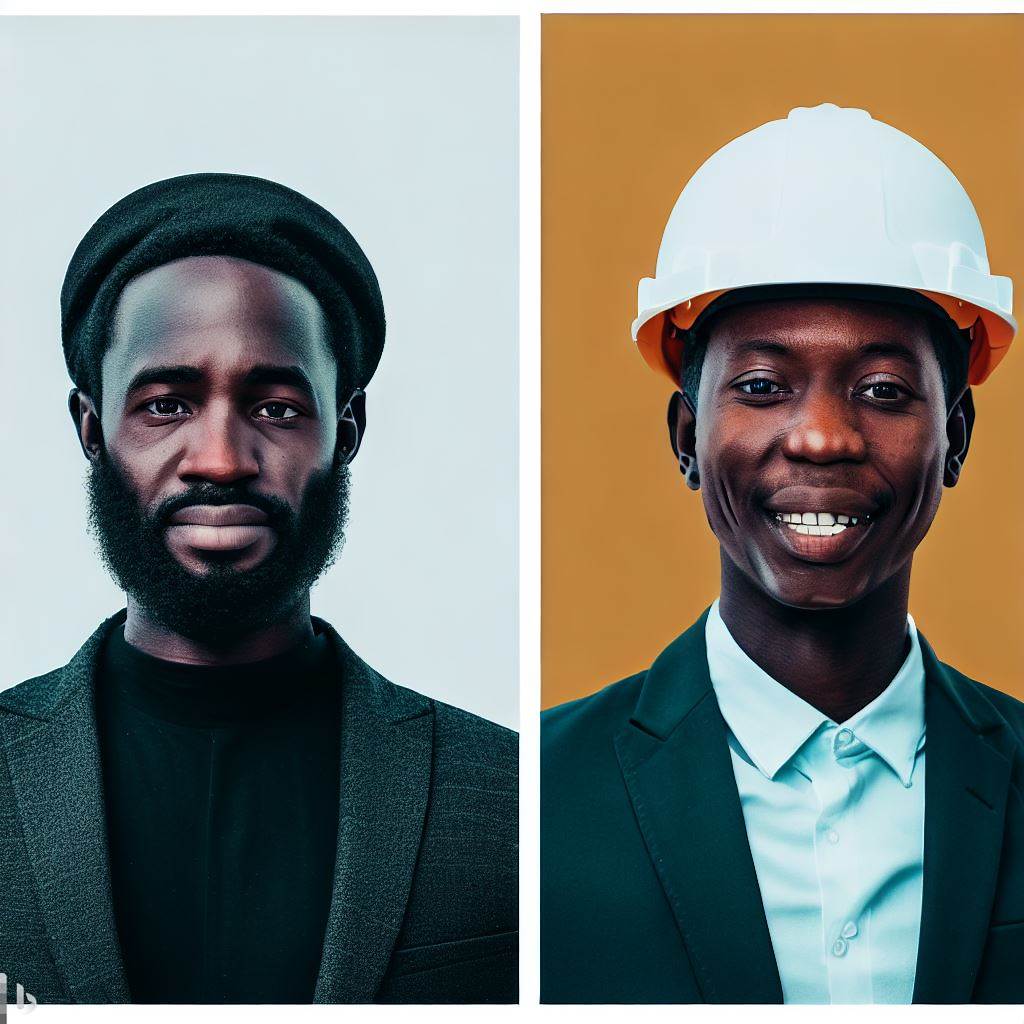Challenges Faced by Nigerian Architects: A Deep Dive
Last Updated on September 22, 2023
Introduction
Architecture is the art and science of designing buildings and other physical structures. It involves the creation of spaces and structures that are functional, safe, and aesthetically pleasing.
In Nigeria, architecture plays a crucial role in shaping the country’s urban landscape and promoting economic growth.
However, Nigerian architects face several challenges that hinder their ability to provide quality services.
These challenges include inadequate infrastructure, lack of funding, and a shortage of skilled labor.
The purpose of this blog post is to highlight these challenges and discuss possible solutions that can help Nigerian architects overcome them.
Through this blog post, we hope to raise awareness about the difficulties faced by Nigerian architects and encourage stakeholders to support the development of the architecture industry in Nigeria.
Read: Exploring the Evolution of the Architecture Profession in Nigeria
Lack of basic infrastructure
Lack of basic infrastructure is one of the major challenges faced by Nigerian architects. The poor state of infrastructure in Nigeria is mainly due to inadequate funding, corruption, and poor maintenance culture.
Explanation of the Poor State of Infrastructure in Nigeria
Nigeria is the largest oil-producing country in Africa, yet basic infrastructure such as roads, bridges, power supply, and water supply are in a deplorable state.
The Nigerian government has failed to provide adequate funding for the construction and maintenance of basic infrastructure, leading to its dilapidation.
Corruption has also led to the embezzlement of funds meant for infrastructure projects, and without maintenance, these infrastructures deteriorate rapidly.
How it Negatively Affects Architects
The poor state of infrastructure in Nigeria adversely affects architects as it hinders the proper execution of their projects.
Architects require basic infrastructure such as good roads, power supply, and water supply to transport materials and equipment to construction sites.
The absence of these essential infrastructures leads to increased transportation costs and delays in project delivery.
The inadequate power supply also limits the use of machinery and equipment, leading to longer construction times and increased costs.
Furthermore, the poor state of infrastructure discourages foreign investment, limiting job opportunities for architects.
Examples of How it Hinders Building Construction
- Bad roads make it difficult to transport building materials, leading to delays and increased transportation costs.
- The power supply is inadequate, leading to limited use of machinery and increased reliance on generators for power, leading to additional costs.
- Poor water supply limits the availability of water required for mixing concrete and other building activities, leading to delays and additional costs.
- Unsafe bridges limit the transportation of heavy building materials, restricting progress on construction sites.
In essence, the lack of basic infrastructure remains a significant challenge faced by Nigerian architects.
This challenge hinders the proper execution of building projects, leads to increased costs and project delays, discourages foreign investment, and limits job opportunities for architects.
The Nigerian government needs to prioritize the development and maintenance of basic infrastructure to support architectural development in the country.
Read: Working Conditions for Aviation Professionals in Nigeria
Bureaucratic hurdles
Bureaucratic hurdles are among the significant challenges faced by Nigerian architects in the construction industry.
The bureaucracy refers to the complicated and time-consuming processes that architects have to go through to obtain necessary permits and approvals before commencing a construction project.
The bureaucracy affects architects’ work process in several ways. Firstly, it slows down the entire construction process, resulting in longer project delivery times and increased costs.
For instance, architects have to obtain several permits, including building/development permits, environmental permits, and fire safety, among others.
Furthermore, the bureaucracy makes it challenging for architects to fulfill their clients’ needs within the expected time frame.
Architects have to consult with officials to obtain permits, which takes a lot of time. This means that project delivery times are often much longer than expected, causing clients to lose faith in the architect’s ability to fulfill their requirements.
Examples of how bureaucracy
slows down building construction include delayed approvals, high processing fees, and the need for multiple approvals from different departments.
For instance, when architects submit a plan for approval, the technocrats in charge might not view it within the expected time frame if they are too busy. Consequently, the architects’ work suffers, and clients are dissatisfied.
Another example is the inconsistency across different local governments in Nigeria.
Some give building permits without much scrutiny, while some are very strict with their requirements and take a long time to approve the permits.
This inconsistency causes confusion among architects who are looking to get permits for their project.
In summary, bureaucratic hurdles have a significant impact on the work process of Nigerian architects. They cause delays in project delivery, increased costs, and ultimately affect the reputation of architects in the industry.
There is a need for a streamlined process of obtaining permits to facilitate the swift completion of construction projects.
The government must implement comprehensive measures to reduce bureaucratic barriers and ease architects’ work process.
This will enable Nigerian architects to contribute to the country’s development with globally standardized infrastructure.
Read: Understanding Safety Standards in Nigeria’s Aviation

Inadequate funding
Inadequate funding is one of the significant challenges faced by Nigerian architects in their profession.
Building construction is a costly venture, and it requires substantial resources to execute a standard construction project. The construction process involves several materials, equipment, and labor, which all require funding.
However, the reality in Nigeria is that the cost of constructing a building is high, and there is often inadequate funding to execute a project to completion.
As a result, architects are left with very limited options to complete a job within the given budget. Architects are forced to compromise on the materials used and often work with limited resources, leading to sub-standard designs and buildings.
The lack of funding affects architects in several ways, with the most critical being their inability to execute their designs to the expected level of quality.
Architects use their creativity, skills, and knowledge to design buildings that meet the desired specifications of their clients. However, without proper funding, architects cannot execute their designs correctly, leading to sub-standard construction.
Furthermore, inadequate funding also affects the timely completion of construction projects.
Architects face the challenge of completing jobs within the set deadlines since they often have to source for funds mid-way through the project.
This leads to project delays, which translates to additional costs and ultimately affects the quality of the job.
To further understand how inadequate funding affects the quality of building construction, examples of the various building projects that have been executed on limited resources abound in Nigeria
In most cases, buildings constructed without adequate funding turn out to be structurally unstable, unsafe, and prone to damage.
Inadequate funding affects
Not only the construction but also the maintenance of buildings. When there is insufficient funding, owners may delay regular maintenance on their properties, leading to dilapidation, and ultimately unsafe living environments.
This situation often affects people living in informal settlements where there are no strict regulations regarding building structures and poor maintenance affects the lives of hundreds of thousands of people.
In short, the challenges faced by Nigerian architects are vast, with funding being one of the critical ones.
Inadequate funding affects the quality of construction and the timely completion of projects, leading to sub-standard buildings.
It is time for stakeholders to address the funding challenges and provide adequate resources to architects to execute their jobs effectively.
By doing so, we can ensure that the buildings constructed in Nigeria are safe, structurally sound and serve the needs of communities, and ultimately, the nation at large.
Read: Pioneers and Influencers in Nigeria’s Aviation Industry
Unskilled workforce
One of the major challenges faced by Nigerian architects is the lack of skilled workforce. The dearth of skilled labor in the country can be attributed to several factors.
Firstly, most young people in Nigeria prefer to pursue white-collar jobs rather than blue-collar ones.
Secondly, the lack of emphasis on vocational training and technical education in the educational system means that there are few opportunities for young people to acquire the skills needed for construction work.
Thirdly, the high rate of urbanization in Nigeria has led to many unskilled laborers being drawn from rural areas to the cities where they have limited access to training.
The lack of skilled workforce affects the work of architects in several ways. These include:
- Delays in project completion: Due to the shortage of skilled laborers, architects often have to rely on unskilled laborers, who take longer to complete tasks due to their lack of expertise.
- Poor quality of work: Unskilled laborers may not have the necessary knowledge and skills to carry out tasks to the required standards. This can result in shoddy workmanship and poor quality buildings.
- Safety concerns: Construction sites that are staffed by unskilled laborers are more prone to accidents. This can result in injury to workers, damage to property, and financial loss to the contractor.
- Increased project costs: Contractors may have to pay higher wages to attract skilled laborers, which can add to the overall project costs.
Several examples show how the lack of skilled labor affects building construction in Nigeria
Firstly, there is a shortage of trained bricklayers in the country, which means that many buildings are constructed using unskilled laborers who lack the expertise to lay bricks to the required standards. This can lead to poor quality buildings that are prone to collapse.
Secondly, the lack of skilled carpenters means that many buildings are constructed using substandard wooden frames.
This can lead to problems with the structural integrity of buildings and make them more susceptible to termite damage and other problems.
Thirdly, the absence of trained electricians means that many electrical systems in buildings are installed by unskilled laborers who may not be familiar with the proper safety procedures for electrical work.
This can result in electrical hazards and increased risks of electric shock and fire.
To tackle the challenge of the lack of skilled workforce, Nigerian architects and construction companies need to take several steps
Firstly, they need to invest in upskilling and training programs for young people interested in construction work. This can be done through collaboration with technical colleges and vocational training centers.
Secondly, architects and construction firms should invest in apprenticeship programs to provide on-the-job training to young people interested in construction work. This can help to develop the skills of these young people while also providing them with valuable work experience.
Thirdly, Government policies that incentivize the establishment of training centers and vocational schools will also go a long way to address the dearth of skilled labor. These policies can include tax incentives, grants, and subsidies for training programs and vocational schools.
Basically, the lack of skilled workforce is a major challenge faced by Nigerian architects. The shortage of skilled laborers in the country affects the quality of building construction, safety, and costs.
To tackle this challenge, architects, companies, and the Government must work together to invest in training programs, apprenticeships, and vocational schools that will create a sustainable pool of skilled labor in the country.
Read: Dissecting The Architect Registration Council of Nigeria
Inefficient construction methods
When it comes to construction, architects are responsible for designing buildings that are not only aesthetically pleasing but also have functional and practical elements.
However, in Nigeria, architects face a number of challenges, one of which is inefficient construction methods.
In Nigeria, many construction projects still rely heavily on traditional building techniques that are inefficient and outdated.
For example, many builders still use mud bricks or concrete blocks that require a lot of time to build, are prone to cracking, and offer little insulation against the extreme weather conditions in the country.
This inefficient construction method affects architects in many ways
Firstly, they have to design buildings that can be constructed using these traditional techniques, which are often limiting in terms of design flexibility and creativity.
Architects have to work within the limitations of these building materials to design structures that are both functional and beautiful.
Secondly, architects have to take into account the limitations of these construction materials when designing buildings that can withstand the harsh Nigerian weather conditions.
With little insulation, buildings can become unbearable during the hot season and freezing during the cold season.
Additionally, these construction methods pose a significant challenge in terms of quality control.
Due to the high humidity levels in Nigeria, buildings constructed using these traditional methods are highly prone to moisture damage. This can cause mould growth, which can be detrimental to the health and well-being of the occupants of the building.
Another issue with these traditional construction methods is the low durability of the buildings
Buildings using these methods last only 10-15 years due to cracking and structural issues.
Inefficient methods endanger workers and occupants with collapsing buildings and safety risks.
Nigerian architects face challenges: limited design creativity, durability, and safety concerns.
They must work with traditional methods while exploring modern, efficient techniques for beautiful and functional structures.
Conclusion
Architects in Nigeria encounter challenges: limited funding, inadequate infrastructure, government support, and tech knowledge.
Addressing these issues is crucial for improving architectural quality and development.
Architecture’s role is critical; Nigeria must establish a supportive environment for architects’ significant contributions.
Solving challenges demands collaboration among stakeholders in the construction and design industry, raising architectural standards nationwide.


